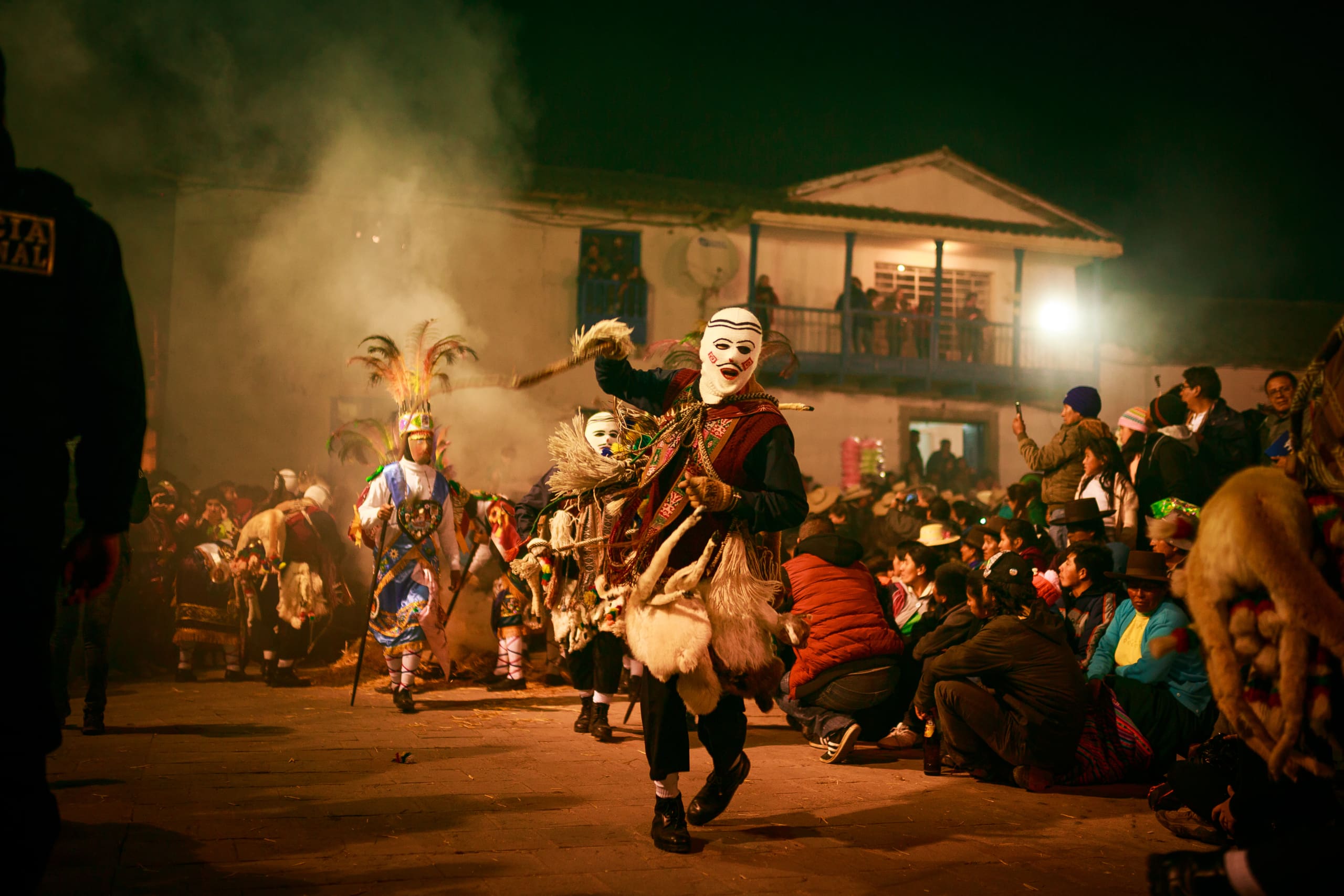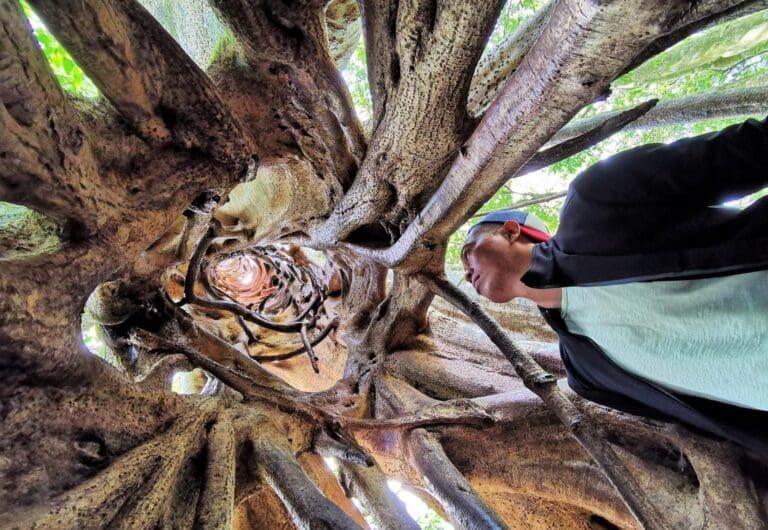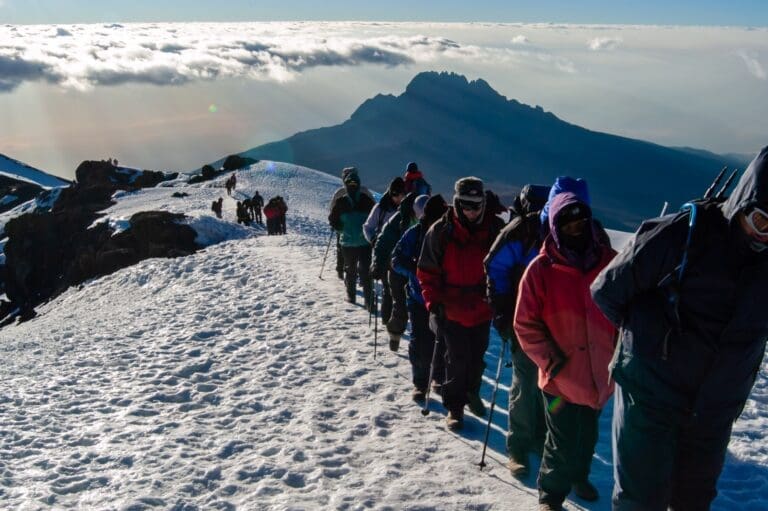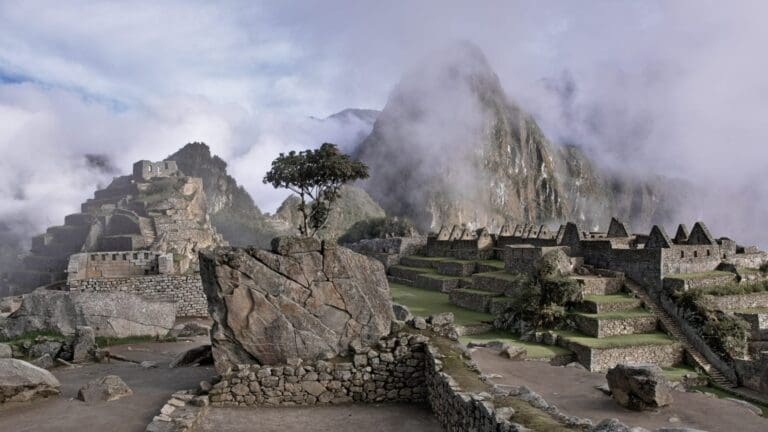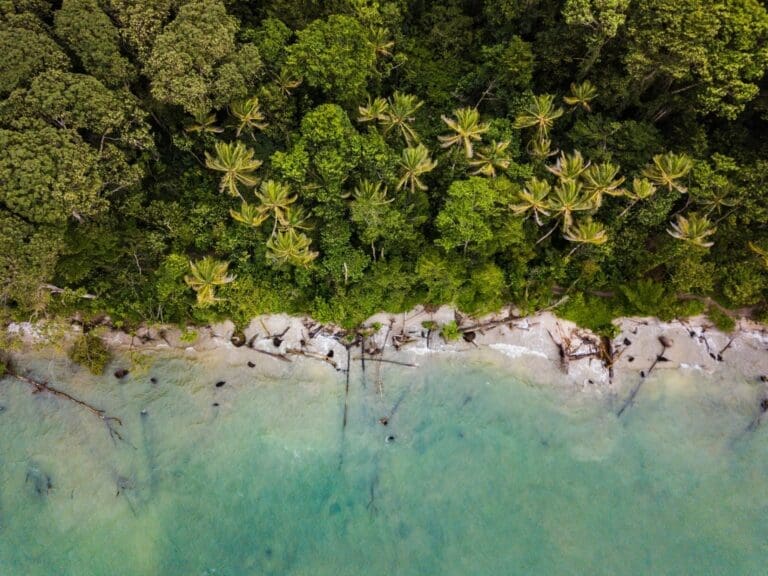All You Need to Know About the Virgen del Carmen Festival in Peru
The Virgen del Carmen Festival in Paucartambo is one of the most unique cultural experiences in Peru. And that’s saying something – this is the home of Machu Picchu, the mystical city of Cusco, and the ancient weaver villages of Huaran, after all! This multi-day Peruvian festival showcases the fusion of local folklore and rich Christian traditions that thrives in these high-up communities.
Intrepid visitors who visit Paucartambo during the Fiesta de la Virgen del Carmen celebration will be immersed in frantic fireworks displays, traditional dancing, and haunting parades. They’ll leave having learned a bit more about the enthralling mythology of the mestizo people (a term used to describe people of mixed European and Indigenous ancestry), the epic legend of the Virgen del Carmen (also known as Mamacha Carmen – the central figure of the festival), and the traditions of the Sacred Valley.
This guide will run through everything you need to know about the Festival of the Virgin of Carmen. We have provided a full overview on what happens from start to finish, when and where the Peruvian festival occurs, and the interesting backstory.
And because you love adventure, we’ll even recommend an awesome trek that lets you visit the famous Tres Cruces viewpoint. You’ll explore the unforgettable terrain of the Sacred Valley, where the high Andes descend into the lush Amazon Rainforest, before diving into the fireworks and parades of the famous Peruvian festival.
Expertise in planning trips to Peru
But first, a little background on us. Ever since I was young, I’ve dreamed of exploring this incredible planet. I’ve been very fortunate to have explored over 50 countries across this extraordinary world and made travel my career by founding The Explorer’s Passage. We’re a premier adventure travel company and, in my opinion, the best tour operator in Peru. In fact, our team has over 40 years of combined experience running successful tours there.
Not only do we run unforgettable trips to the Virgen del Carmen Festival in Peru, but we also offer tours to other thrilling Peruvian destinations such as our ever-popular hiking tour on the Inca Trail to Machu Picchu.
If at any point throughout this guide you find yourself with any questions, reach out to our team and we’ll gladly help build your dream trip!
Inside this Guide
- What is the Virgen del Carmen Festival?
- Origins and history of the Virgen del Carmen Festival
- Meaning of the costumes and characters
- When is the Virgen del Carmen Festival?
- Where is the Virgen del Carmen Festival?
- Planning your stay
- How to get to Paucartambo
- What to expect day to day
- Custom trek to the Virgen del Carmen Festival
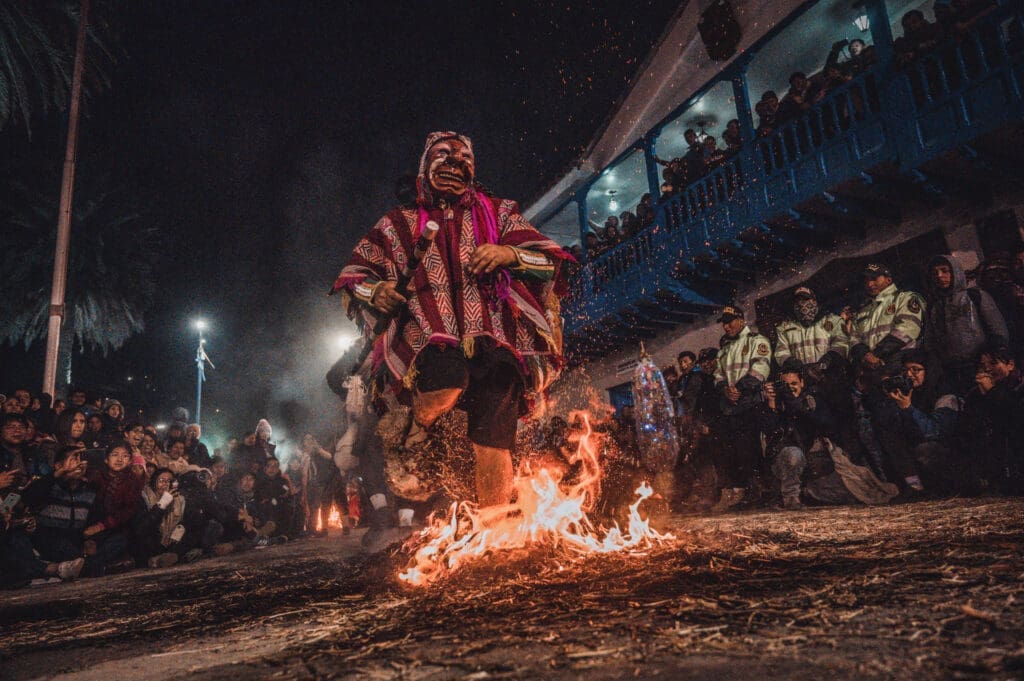
What is the Virgen del Carmen Festival?
This lively annual festival is to honor the Virgen del Carmen (or Mamacha Carmen), the province’s patron saint, and the miracles she bestowed on the people of Paucartambo. What happens during this highly anticipated religious celebration attracts both tourists and locals alike to the streets of Paucartambo.
The main celebration of the Virgen del Carmen Festival in Peru is a 72-hour rollercoaster ride through wild folk dances, fireworks, fascinating mythology, and incredible human performance. But there are also thoughtful, meditative moments mixed in, plus a thread of deep Christian religiosity that’s palpable in the air.
By the end of the Paucartambo Festival (another name for the Virgen del Carmen Festival), you’ll know all about the meaning and history of the Virgen of Carmen. Expect also to indulge in delicious local food and drink throughout this Peruvian festival. If you’re in Peru at the right time of year and have a few extra days on your trip itinerary, the Virgen del Carmen Festival is definitely worth a visit.

Origins and history of the Virgen del Carmen Festival
The roots of Mamacha Carmen and the Virgen del Carmen Festival can be traced back to the 13th century. The story goes that a female merchant was making her way to the Peruvian village of Paucartambo one morning, carrying an exquisite silver plate to trade in the market. As she approached, she happened upon a beautiful human head. She placed the head on her plate, and it suddenly began to speak.
The message? That the magical talking head was the mouthpiece of Mamacha Carmen, an angelic protector who came to heal the woes of the people of Paucartambo and the high Andes. She proceeded to perform a series of miracles, relieving the sick and changing the fortunes of villagers. As for the locals, they duly made the Virgin of Carmen their patron saint and instituted an annual festival in her honor: The Virgen del Carmen Festival.
Although the Spanish colonists who came to Peru in the 1530s banned the Peruvian festival, it’s likely that the story became entwined with their imported Catholic mysticism. That added an extra dimension to the affair, and now this religious festival is seen as something of a fusion of long-held Incan beliefs and later Christian zeal.
The Paucartambo Festival was finally reinstituted in 1944 by a group of artists and continues to run to this day. The characters involved in the traditional dances of the parades are important representations of the meaning of the Virgen del Carmen festival, so let’s meet a few of them!
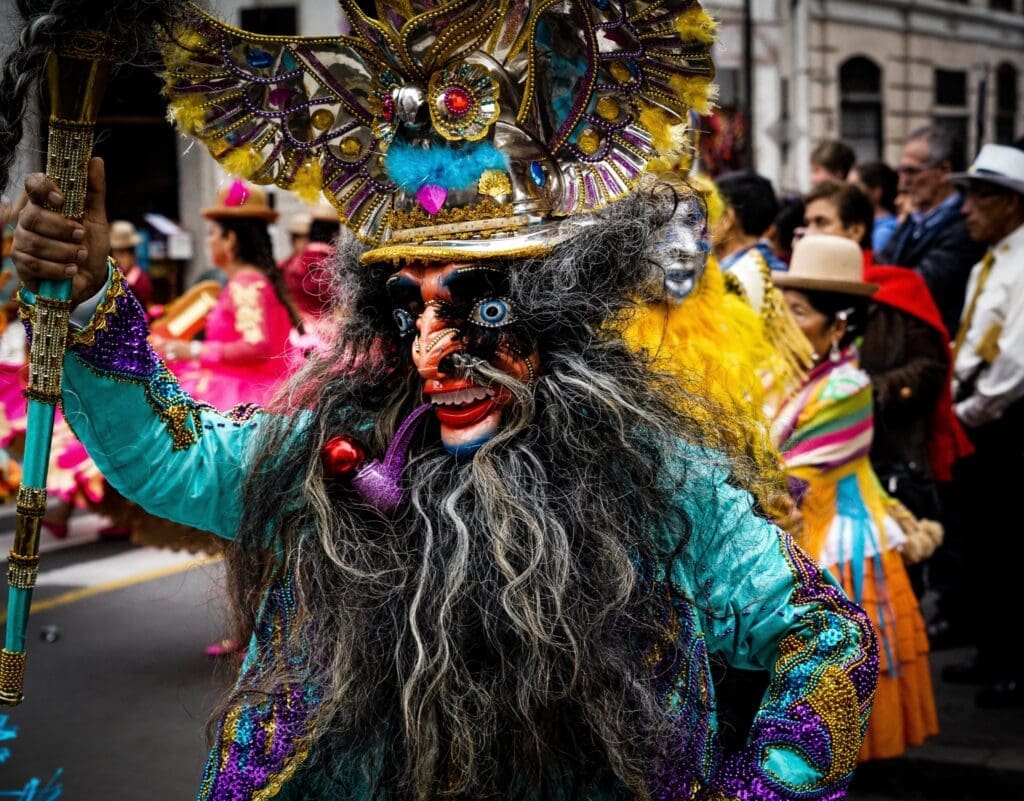
Meaning of the costumes and characters
The eye-catching costumery and traditional dances of the Paucartambo Festival are steeped in the deep backstory for Virgen del Carmen. Different troupes lead the parades on different days performing skits or traditional dances depicting events in Peruvian history. Some light fireworks while others perform cultural dances. Then there are some who dutifully usher the religious icons through the streets, protecting the Mamacha Carmen from evil demons who threaten her and tempt the faithful.
Here are just some of the unique characters that you’ll see represented during the Peruvian festival:
- Spanish Conquistadors – These are parody caricatures of the Spanish invader, colored with a red face to depict their drunkenness.
The story of Virgen del Carmen is rich and you’ll see definitely see it portrayed in the many intricate costumes.


When is the Virgen del Carmen Festival?
The Virgen del Carmen Festival happens once per year during mid-July in a small town in Southern Peru. The main day of the religious festival is typically around the 16th of July, which matches up with the festival of the Virgin Mary across much of the Catholic world.
Because it’s now such a big affair, anyone traveling through in early July or even late June is likely to see some preparations underway for the lively religious festival.
Where is the Virgen del Carmen Festival?
Paucartambo – the home of the Virgen del Carmen Festival – is one of the easternmost towns of the Cusco Andes in South America. Famously, it sits right on the cusp between the dry and arid western mountains and the beginning of the Amazon rainforest.
Normally a relatively quiet town, Paucartambo really comes to life during the Virgen del Carmen Festival. Thousands of locals and tourists flock to the streets to celebrate Mamacha Carmen by enjoying the parade, vibrant costumes, traditional dancing, live music, Peruvian cuisine, and lively fireworks.
At 9,500 feet above sea level, Paucartambo offers not only a front-row seat to the festival, but also stunning views of the surrounding valleys and cloud forests. Its remote location near the entrance to Manú National Park makes it a unique meeting point between Andean tradition and Amazonian biodiversity—something you can feel in the air during the celebration.
Planning your stay
Since Paucartambo doesn’t attract large amounts of tourists during the rest of the year, finding a place to stay during the Virgen del Carmen Festival can be a challenge. If you book far enough in advance, there are a few hostels available, however many festival-goers opt for camping or staying with a host family for the duration of the Paucartambo Festival.
Take the stress off of your hands by booking your trip with The Explorer’s Passage where we’ll handle logistics like housing for you so you can enjoy the festival worry-free.
How to get to Paucartambo
Getting to Paucartambo for the Fiesta de la Virgen del Carmen requires a fairly straight forward journey. It is recommended to fly into Cusco’s Alejandro Velasco Astete International Airport (CUZ) then travel by car or bus to Paucartambo.
To get to Paucartambo, you’ll need to travel 60 miles (100 km) southeast from Cusco. The road first shoots south to the small market town of Huarcapay and then starts weaving up into the highlands. The drive from Cusco to Paucartambo takes about 4 hours. Another option that is quicker, but more pricey is taking a bus from Cusco to Pisac, then a taxi from Pisac to Paucartambo, arriving in just 2.5 hours.
Paucartambo itself occupies a small dip in the ridges between Qhispi Rumiyuq mountain and Tres Cruces, a well-known pass that offers some of the most spectacular views of the incredibly biodiverse Manú National Park (a UNESCO World Heritage Site where the Tropical Andes and Amazon Basin converge) and the jungles that roll out east.
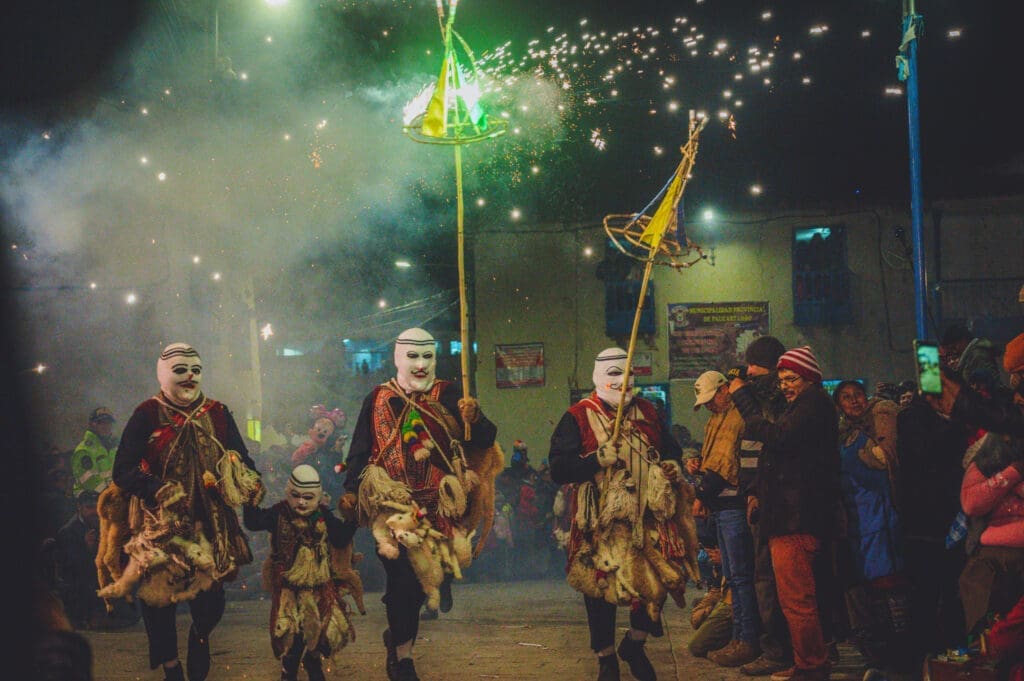
What to expect day to day
Here’s a glimpse of how people celebrate the festival and the many things to do during this special event:
- Day 1 – In the afternoon of the first day of the Fiesta de la Virgen del Carmen, the streets of Paucartambo erupt with a bang, literally. The start of the festival is heralded by whistling rockets, fireworks, and pyrotechnics, set to a clanging backdrop of the village church bells. Get used to the cacophony and the energy – it’s here to stay!
In the evening, the statue of Virgin del Carmen herself is paraded through the streets flanked by boisterous crews of comparsas who shout and sing. Don’t be surprised if they pull you into the mix – they try to get everyone involved in the cultural dances and excitement.
And the fun doesn’t stop there. For the foodie seeking to try some Peruvian cuisine, there’s plenty of drinking and tasty dining well into the early hours of the night.
- Day 2 – The central and most important day of the Virgen del Carmen Festival is all about the main procession of the revered statue of Virgen del Carmen. It is moved slowly through the town and adorned with rose petals and flowers to pay homage to the Christian roots of the religious festival. Watch out as the Wayna Saqras attempt to distract you from Mamacha Carmen by climbing on balconies and rooftops during the parade.
You’re likely to notice the deep Christian devotion of this day – it’s more akin to the Catholic village ceremonies of Spain. But the famous masked troupes and costumed dancers are never far away. They take over once more later on, as stalls open on the streets to sell traditional Peruvian cuisine such as the popular lomo saltado stir fry, ceviche, and beer.
- Day 3 – The Virgen del Carmen Festival winds up with a more somber tone on this day. The locals head to the town cemetery to remember and honor lost loved ones where they light candles and place offerings on graves.
Back in the town, the parades quiet down to allow the local merchants to sell alpaca wool goods and woven crafts. The day has its own procession, flanked by some of the most beautifully dressed dancers of all the days of the Paucartambo Festival. Enjoy your last taste of Peruvian cuisine in Paucartambo before heading home at the end of the festival.
But why just read about such a fascinating celebration when you can experience it for yourself? Check out our recommendation for an unforgettable trip to Paucartambo below.
Custom trek to the Virgen del Carmen Festival
Taking our decades of experience crafting the best trips, we’ve put together a Peruvian festival trek package that culminates with the unique Virgen del Carmen Festival in Paucartambo.
This tour is timed to match up perfectly with the beginning of the iconic parades and processions of the Paucartambo Festival, but first whisks you through one of the less-trodden trekking corners of the Cusco Andes to visit the Tres Cruces viewpoint, then to some of the most iconic Incan sites of the Sacred Valley.
Your itinerary for the Peruvian festival trip can roughly be broken up into three parts:
- Days 1-2: Culture and the Sacred Valley – Explore Cusco itself and then make for the depths of the Sacred Valley.
Here, you’ll sample traditional Peruvian cuisine in a ranch above the Urubamba River, known by the Incans to be a sacred reflection of the cosmic Milky Way. You’ll then have the opportunity to visit the distant town of Ollantaytambo to see Incan ruins and encounter the incredible agricultural terraces of Moray.
- Days 3-4: The Trek – You’ll leave the Sacred Valley behind and transfer over to the eastern side of the Cusco Andes, heading for the famous Tres Cruces viewpoint.
Here, you’ll delve into the lush cloud forests of the Manú National Park, a huge 6,627-square-mile (17,163 km²) biosphere reserve and UNESCO World Heritage Site that sits at the intersection of the Tropical Andes and the Amazon Basin. Our trek through this region of unparalleled biodiversity will lead to conquering the top of Qapac Q’asa, the highest point of our trek, where you can see the stark transition from alpine terrain to tropical rainforest and the very beginnings of the Amazon itself.
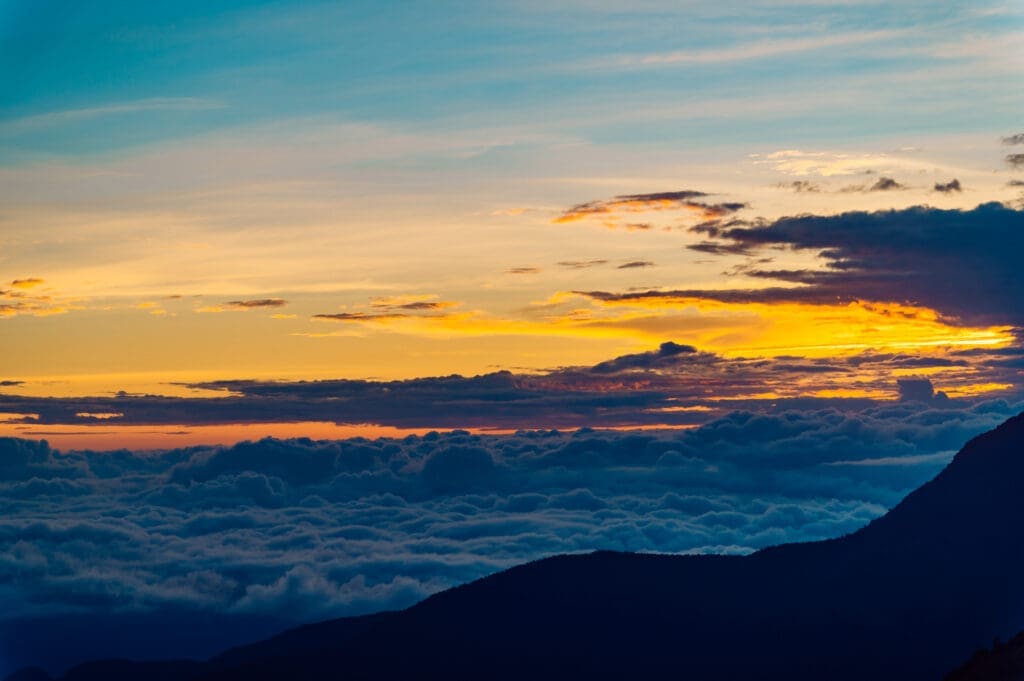
You’ll also get the chance to visit the Three Crosses or Tres Cruces viewpoint, also known as “the balcony to the East.” This viewpoint is famous for its panoramic views of a mirage created as the sun rises over the Cusco jungle and extends across Manú National Park.
This is a top highlight of the trek and is recognized as one of the best places to view the sunrise in the world. The “three suns” or “white lightning” you’ll see upon sunrise at Tres Cruces is a special phenomenon occurring due to the light passing through the humid jungle atmosphere, creating a beautiful optical illusion that can only be seen in Peru and Japan. Arriving at the Tres Cruces viewpoint between 5:00-6:00 AM will secure you a perfect view.
After an early rise, reward yourself with a relaxing soak. There are hot springs and mountain camps to enjoy before heading to Paucartambo.
- Days 5-8: The Festival – After exploring Manú National Park and trekking through the Sacred Valley, you’ll arrive in Paucartambo ready to join the first day of the largest religious festival in Peru. Get ready for lively traditional dancing, delicious local food, and sparkling fireworks!
It’s best to experience the Virgen del Carmen Festival to truly feel, taste, see, hear, and learn about the depths of this vibrant event and the local culture. Join us for the next celebration and let us help plan a trip you surely won’t forget!
Why travel with The Explorer’s Passage?
We pride ourselves on delivering extraordinary tours based on travelers’ needs and are humbled by our guests’ testimonials. In fact, our dedication has earned us a 5-star rating on Tripadvisor, and awards by Travel+Leisure Magazine and Newsweek. Check us out and discover why so many travelers worldwide choose us.
We pride ourselves on delivering extraordinary tours based on travelers’ needs and are humbled by our guests’ testimonials. In fact, our dedication has earned us a 5-star rating on Tripadvisor, and awards by Travel+Leisure Magazine and Newsweek. Check us out and discover why so many travelers worldwide choose us.
My team and I would love for you to join us in Paucartambo or on any of our many other popular adventure trips!
We look forward to you traveling with us soon!
Cheers,
Jeff
Jeff Bonaldi
Founder & CEO
The Explorer’s Passage
About Jeff Bonaldi
Jeff Bonaldi is the Founder and CEO of The Explorer’s Passage, a premier adventure travel company. His mission is to provide travelers with the opportunity to transform their lives and the planet through the power of adventure.
Learn more about Jeff’s story and his company HERE.
Share this amazing location!

